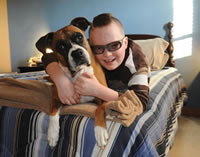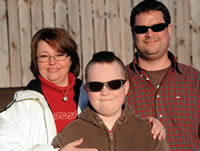A backyard collision sends North Carolina boy to CHKD for emergency surgery.
 When CHKD neurosurgeon Joseph Dilustro first saw Ryan Baxter last August, the 12-year-old’s left eye was out of its socket, resting on his cheek.
When CHKD neurosurgeon Joseph Dilustro first saw Ryan Baxter last August, the 12-year-old’s left eye was out of its socket, resting on his cheek.
“He asked me if he would lose his eye,” Dr. Dilustro recalls. “I told him yes, I thought he would, and I was very sorry. Then this amazing boy said, ‘Well, just don’t tell my parents right now. They’re already pretty upset.’”
Cathy and Randy Baxter, Ryan’s parents, had reason to be upset. Just hours earlier, Ryan and his friend had been riding their mini-bikes in the Baxters’ backyard, just across the Virginia/North Carolina border in South Mills, N.C. On that sunny Saturday afternoon, the two preteens were savoring their final days of summer vacation.
Ryan says he felt something hit his leg so he glanced down to see what it was. When he looked back up, it was too late to stop. He crashed face-first into the corner of the deck.
Though he was wearing a helmet, the edge of the deck railing caught him just below his helmet, above his left eyebrow, fracturing his skull at the eye socket and dislodging his eye. “I really thought I was dead,” Ryan says.
His mom heard the commotion and remembers running outside to see her son coming toward her covered with blood and with what was obviously a very serious eye injury. She rushed to him, horrified. “He kept asking me if he was going to die,” Cathy said. “I thought for sure that he was going to die. It looked so bad.”
An emergency team from the nearby rescue squad responded within minutes. Seeing the severity of Ryan’s injuries, a firefighter offered to drive the ambulance so that both EMTs could ride in the back with the injured boy. They rushed him and Cathy to Norfolk, where physicians and surgeons from the region’s Level 1 Trauma Center at Sentara Norfolk General Hospital collaborate with specialists at Children’s Hospital of The King’s Daughters to care for pediatric trauma patients.
Cathy says she’ll never forget the ambulance ride. “I kept looking back and asking the EMT if he was still awake,” she recalls. “He was so still – not moving at all. I was afraid he would lose consciousness. I knew that would be bad. I cried and prayed.
“I kept ‘seeing’ him running to me with his eye out and I could see his skull. That memory will be with me forever.”
Dr. Dilustro quickly answered the call to the trauma center next door to CHKD where Ryan had arrived by ambulance.
“He was very alert and aware of what was going on,” the neurosurgeon said. “That was a good sign that he had not suffered brain damage.”
There was a very deep cut in Ryan’s forehead above the brow line and a severe fracture of the skull and orbit – the bone that surrounds the eye. Ryan needed immediate surgery to attend to the eye injury as well as the skull and facial injuries.
 Dr. Dilustro joined the surgical trauma team on call that night for Ryan’s surgery. In the OR, they found Ryan’s eye could not be saved, so his eyeball was removed. The eyelid was stitched closed to protect the area from exposure. The next step was to explore the injury to the skull – and potentially his brain – by accessing the injury through the gash in Ryan’s forehead. Dr. Dilustro says they found a pinhole-sized tear in the dura, the tough membrane that surrounds the brain and contains the spinal fluid. It would have to be repaired quickly to prevent the protective fluid from around the boy’s brain from leaking out.
Dr. Dilustro joined the surgical trauma team on call that night for Ryan’s surgery. In the OR, they found Ryan’s eye could not be saved, so his eyeball was removed. The eyelid was stitched closed to protect the area from exposure. The next step was to explore the injury to the skull – and potentially his brain – by accessing the injury through the gash in Ryan’s forehead. Dr. Dilustro says they found a pinhole-sized tear in the dura, the tough membrane that surrounds the brain and contains the spinal fluid. It would have to be repaired quickly to prevent the protective fluid from around the boy’s brain from leaking out.
“The tear was in a very awkward place, so we could not stitch it closed,” he said. “Instead we used a small patch on the dura that could hold back the leaking spinal fluid until it healed.”
The final step in the surgery was to repair the dislocated bone around the eye, then stitch the gash in Ryan’s brow.
After the surgery, which lasted more than four hours, Ryan was moved to CHKD’s pediatric intensive care unit, where he was monitored around the clock. Cathy and Randy were there day and night, watching hopefully for signs that their son was recovering. It wasn’t long before they were thrilled to see marked improvement in his condition. In fact, just two days after his surgery, they returned from a meal to find him playing a video game in his ICU bed.
But a few days later, that hopeful sign gave way to a new worry when Dr. Dilustro told them that spinal fluid had begun to leak from Ryan’s injured eye socket. He wanted to do everything possible to avoid taking Ryan back into surgery.
“By diverting the spinal fluid from the original area of the leak behind his eye socket and draining it elsewhere, we could give the leak a chance to heal on its own,” Dr. Dilustro explained. The solution was to insert a small catheter into Ryan’s lower back to divert the leaking fluid then monitor Ryan constantly to make sure the leak was healing and there was no infection. Two weeks later, there was no longer any sign of the spinal fluid leak, so the catheter was removed. There was no need for additional surgery.
Incredibly, Ryan was even able to keep up with his schoolwork as he recovered, thanks to bedside tutoring with a hospital schoolteacher. And his friends and classmates helped cheer him with visits and cards while he was monitored in the PICU.
After 23 days in the hospital, Ryan went home with instructions to limit physical activity for a while. “That was a little challenging for him,” his dad said. Homeschooling three days a week has helped Ryan keep up with his classmates.
On November 24, the day before Thanksgiving, he returned to CHKD for the next stage of his treatment: surgery to insert a temporary orb into the eye socket as a sort of place-holder until his permanent prosthetic eye is implanted.
Though the loss of his eye is a challenge for Ryan, he has handled it with remarkable maturity and optimism. He is grateful for his life and that his helmet protected his brain from serious damage. Dr. Dilustro agrees that Ryan’s helmet significantly reduced his injury.
Cathy and Randy say they are especially grateful for the experts at CHKD who returned their son to them. “We’re blessed to have Children’s Hospital here in this region,” Randy said.
Cathy has worked at CHKD Medical Group’s Coastal Pediatrics in Elizabeth City. “We felt the special care of CHKD and my colleagues,” Cathy said. “They were just as concerned about us as parents as they were for Ryan. They treated us like family, and I can’t begin to say enough good things about them.”
The Baxters say Ryan’s accident may have triggered a new sense of awareness among their neighbors for the potential for accidents. “There are usually a lot of dirt bikes and four-wheelers around here,” Randy explained. “But lately we’ve noticed more bicycle riding, and the neighborhood is quieter.”
Dr. Dilustro practices with CHKD Surgical Group’s neurosurgery practice. Other surgeons on Ryan’s case included neurosurgeon Tina Rodrigue, plastic surgeon Douglas Trzcinski and ophthalmologist William Blaylock.
This story was featured in the first quarter 2011 issue of KidStuff, a publication of Children's Hospital of The King's Daughters. Click to read more patients' stories.